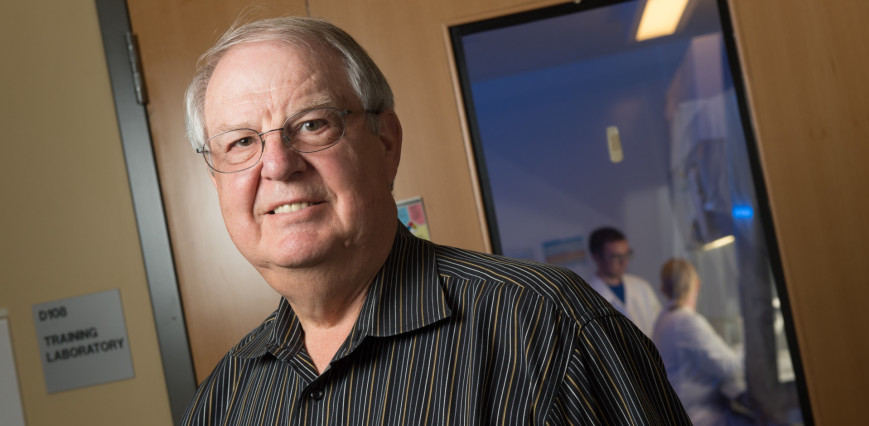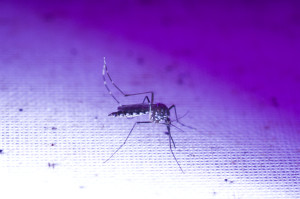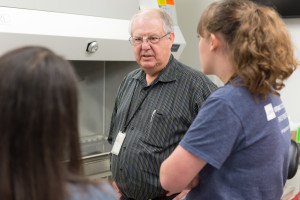
The Colorado State University officer charged with protecting researchers and the public from infectious research pathogens has received international honors for effective safeguards that support research success.
Bob Ellis, CSU biosafety director, earned the Everett Hanel, Jr. Presidential Award from the American Biological Safety Association for outstanding work promoting biosafety and high professional standards.
A professor in the Department of Microbiology, Immunology, and Pathology, Ellis has served as director of university biosafety for about 20 years. The role requires oversight and training to ensure that all CSU research involving infectious microorganisms and recombinant DNA is conducted according to university and national standards and guidelines.
Ellis is responsible for establishing protocols for safety and security in Colorado State research laboratories that investigate bacteria, viruses and other infectious agents with the aim of preventing, treating and curing significant global diseases. These diseases – often affecting people, animals and plants worldwide – include tuberculosis, dengue fever, West Nile virus, malaria, plague, rabies, rice diseases and many others.
Among other duties, Ellis helps prevent exposure to materials that are held in Biosafety Level 3 labs and could pose a threat to animal and human health. This laboratory space reflects the highest Biosafety Level at CSU and is mainly at research facilities on the Foothills Campus.

Ensuring safe and secure research facilities is foundational to science that thwarts disease, said Dr. Gregg Dean, a research veterinarian and head of the Department of Microbiology, Immunology, and Pathology.
“We have a great biosafety and biosecurity program here at CSU, and it is critical for us to perform our infectious disease research,” Dean said. “Bob’s award is well-deserved recognition!”
Ellis has held eminent positions in the field of biosafety and biocontainment, leads training for international professionals, and teaches graduate-level courses in laboratory safety. He credited colleagues for the honor – and answered questions about his work.
Many of us associate the term “biosafety” with disease outbreaks – an extreme example being the 2014 Ebola outbreak in West Africa – and efforts to prevent the spread of viruses, bacteria, fungi and parasites that cause infectious disease. This all seems frightening or fascinating, or both. What drew you to this field and to your work?
I didn’t plan on it. I was appointed to the biohazard committee in 1978. I became chair of that group in the early 1980s, and we decided we needed a biosafety officer. At first I didn’t apply, but was encouraged to, so I did and was the successful candidate. From 1989 to 1997 other people held the biosafety officer position and I was doing animal disease research. Then the position opened back up, so I applied and was selected in a national search. Since then our research has grown to the point where we have two full-time and two part-time employees in addition to me.
I like working with people. I enjoy helping people with their research. You need someone in this job who understands the research. Having done the research and being trained as a microbiologist, I understand what people are doing in the research laboratories.
Why is biosafety important at a research university, and what does doing it successfully help us to achieve?
The results benefit humans, animals and plants. A lot of our human vaccines were developed in animals first. A lot of the equine vaccines for West Nile virus were tested and proven here, as were some of the new rabies vaccines for horses. Some of the newest vaccines for tuberculosis are being developed here. To do that, you need the resources from a lab standpoint and resources from a training standpoint to do it correctly and safely.
Biosafety typically is concerned with pathogens that have the potential to cause infectious disease in plants, animals and people. How many infectious agents do CSU researchers study, and what are a few examples of pathogens at the center of some of our well-established research programs?

Agents we work with include West Nile virus, rabies, tuberculosis, plague, tularemia, MERS and brucellosis. All of these are zoonotic, which means they are transferable from animals to humans. There are dozens of pathogens being studied by hundreds of researchers. We’re right at the top for BSL-3 research. People turn to CSU researchers to collaborate with them on many aspects of research, and they come to us in biosafety for training.
Is it ever scary or stressful working with these agents?
It’s only scary or stressful if you’re not prepared. And we put a lot of energy and resources into making sure people are prepared. We are very strict about who is suitably qualified to do the job. We prepare people so that if something does go wrong, they’re ready to handle it. For those conducting research at the BSL-3 level, we require intense training, followed by required refresher training annually and constant observation by peers. The main goal for biosafety is to work with the research community and make sure the protocols being used are the best procedures to follow in the research.
Could you define the biosafety levels that are used to characterize laboratory space, and describe which of those levels and how much laboratory space we have at CSU?
There are four levels. BSL-1 deals with agents that don’t cause disease in normal, healthy, human adults. Level 2 is for diseases that can cause human disease but can be prevented or are highly treatable. BSL-3 is for agents that cause diseases in humans that are not as easily treatable, and a lot of them are vector-borne (which means they are carried through other organisms like mosquitoes) or are transmitted through respiratory routes. BSL-4 is for viral diseases for which there are no treatments or vaccines, like Ebola. In BSL-2 you wear lab coats and gloves. In BSL-3, what you wear varies, depending on what you’re working with. In our BSL-3 facilities, all air is HEPA-filtered on the way out. We’re not required to do it, but we do it, just to go the extra mile. BSL-3 is our highest laboratory level, and we have about 50,000 square feet of BSL-3 research space in three locations. In the year 2000, we only had 9,000 square feet of BSL-3 space, at the Foothills Campus, so we’ve grown.
Biosafety is a bit like airplanes landing: When it’s going well, people hear very little about it. What are three important aspects or guiding principles of biosafety work that people would be interested to know?
- A valid risk assessment. What is it you’re working with, and how do you protect yourself, the community and the environment from what you’re working with?
- Then develop standard operating procedures for what you’re going to do.
- Finally, develop the training program to ensure that people are trained and have the tools to do their work safely. It all centers around the people. It doesn’t matter how good the building, training, or equipment is, if they aren’t used correctly, the program won’t be as good as it should be.
What are the top factors that make CSU’s biosafety program successful?
We stay at the top of our profession in training, knowledge and ability to transfer that to the people in the labs. Communication is huge; the whole program can fall apart if you don’t communicate effectively. Having really good administrative support and investigator support is extremely important. Working with the research community and administration here at CSU, we’ve established a safety culture over the years, and when people from the outside come in, they feel that. It’s not an overly oppressive or burdensome regulatory system, but if we can’t do the research safely, we won’t do it.